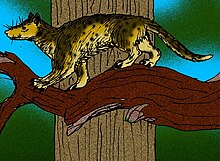Miacis
Miacis is a small extinct carnivore of the family Miacidae. They were small mammals which lived in forests and climbed trees, and ate small prey. They had the ancestral mammalian number of 44 teeth. In later members the number of teeth began to be reduced.
| Miacis Temporal range: Palaeocene to late Eocene
| |
|---|---|

| |
| Scientific classification | |
| Kingdom: | |
| Subphylum: | |
| Class: | |
| Superorder: | |
| Order: | |
| Family: | |
| Genus: | Miacis Cope, 1872
|

Miacis had brains that were relatively larger than those of the creodonts. The larger brain size compared to body size suggests their behaviour was becoming more flexible, and possibly more intelligent.
Miacids are either early members of the order Carnivora or in a larger group called the Carnivoramorpha. They may not be monophyletic. One professional opinion is that most Miacis species belong to the ancestors of the modern order, the crown-group Carnivora.[1][2]
The miacids lived 50 to 60 million years ago and were small omnivorous predators. According to one source, it preyed on smaller animals, such as small mammals, reptiles, and birds, and might have also have eaten eggs and fruits.[3]
Some experts think it is a paraphyletic taxon.[4] In other words, they think the name Miacis covers a number of different species.
References
change- ↑ Wesley-Hunt G.D. & Flynn J.J. 2005. Phylogeny of the Carnivora: basal relationships among the Carnivoramorphans, and assessment of the position of 'Miacoidea' relative to Carnivora. Journal of Systematic Paleontology, 3: 1-28. [1]
- ↑ Spaulding M; Flynn J.J; Stucky R.K. 2010. A new basal Carnivoramorphan (Mammalia) from the ‘Bridger B’ (Black’s Fork Member, Bridger Formation, Bridgerian NALMA, Middel Eocene) of Wyoming, USA. Paleontology 53: 815-832. doi:10.1111/j.1475-4983.2010.00963.x
- ↑ Palmer D. (ed) 1999. The Marshall illustrated encyclopedia of dinosaurs and prehistoric animals. London: Marshall Editions, 214. ISBN 1-84028-152-9
- ↑ P.D. Gingerich 1983. Systematics of Early Eocene Miacidae (Mammalia, Carnivora) in the Clark's Fork Basin, Wyoming. Contributions from the Museum of Paleontology, University of Michigan 26(10):197-225